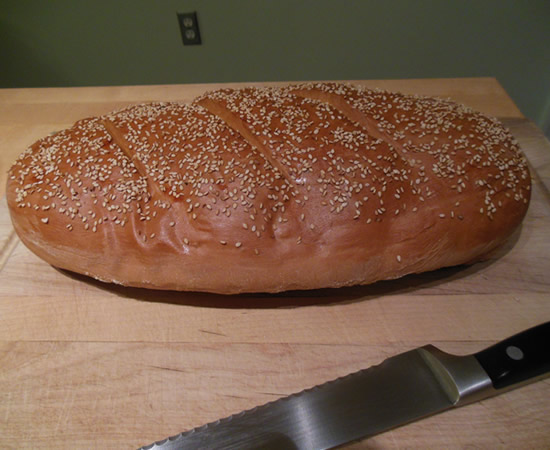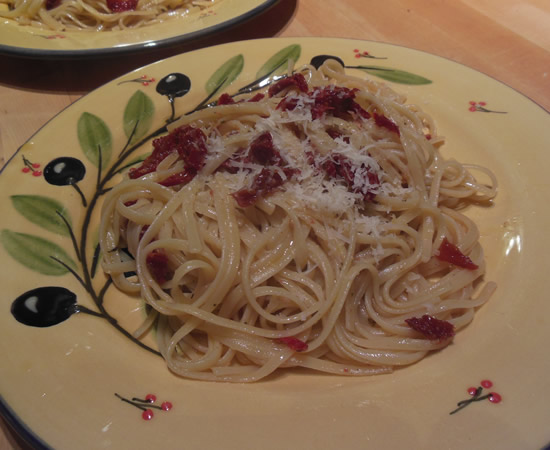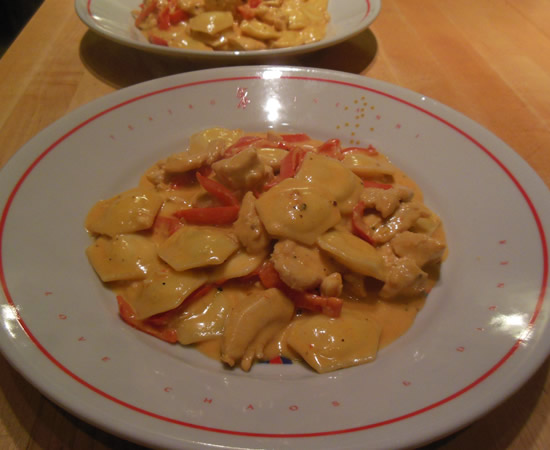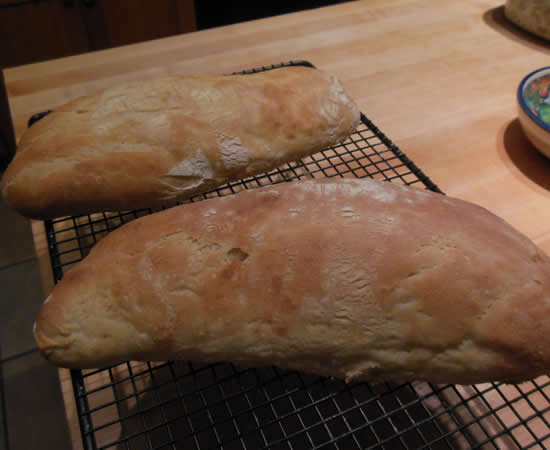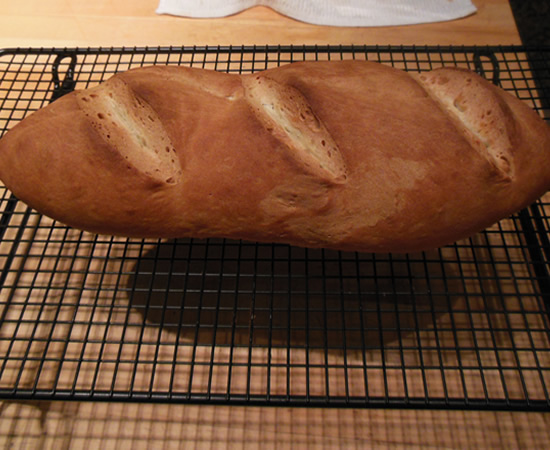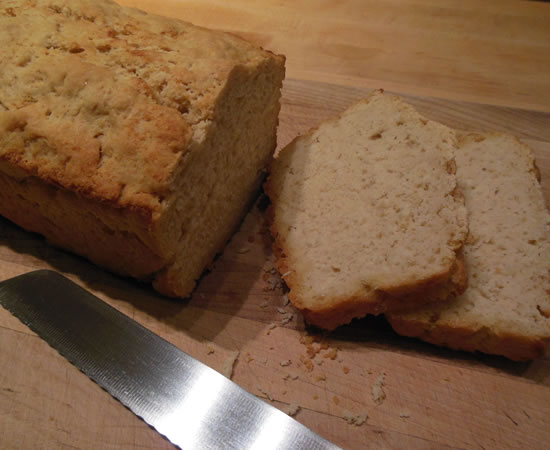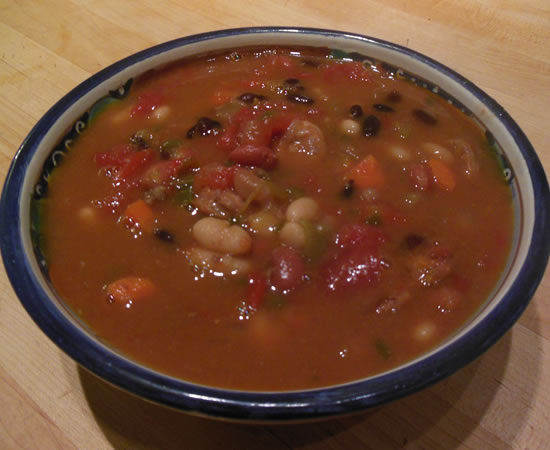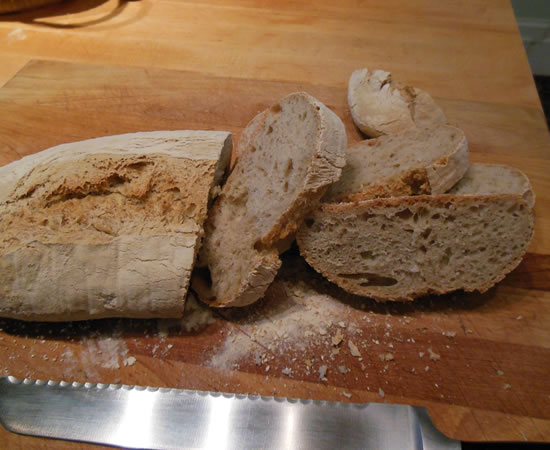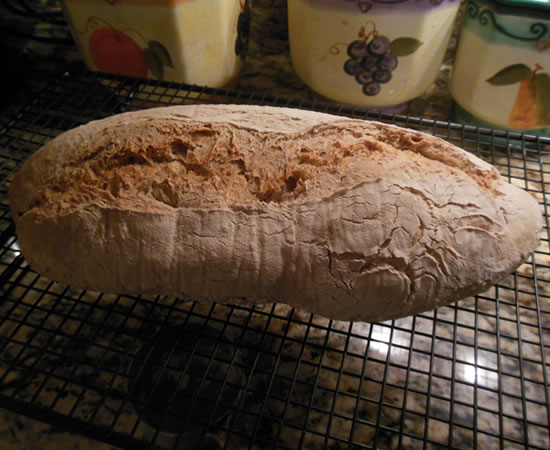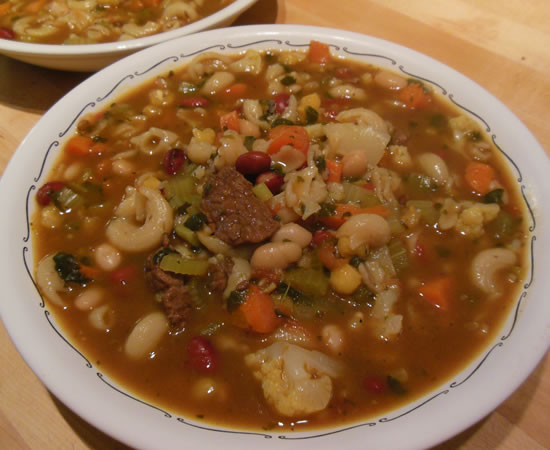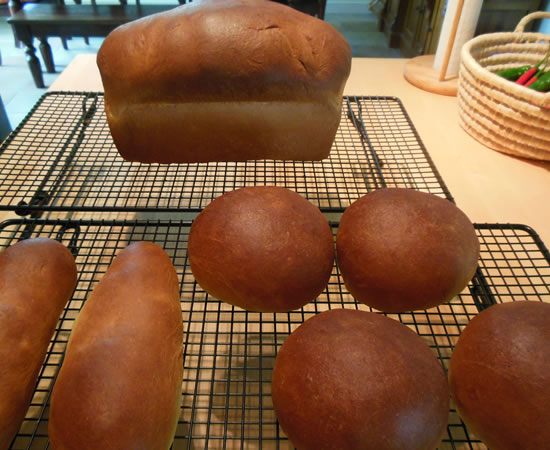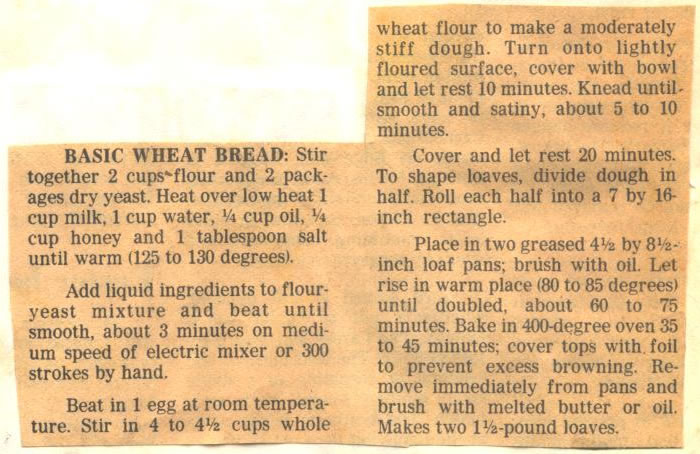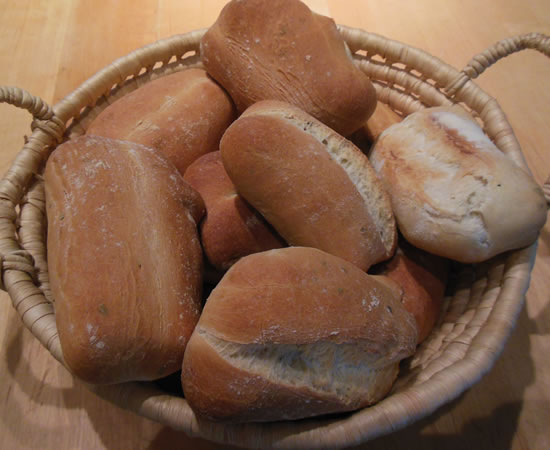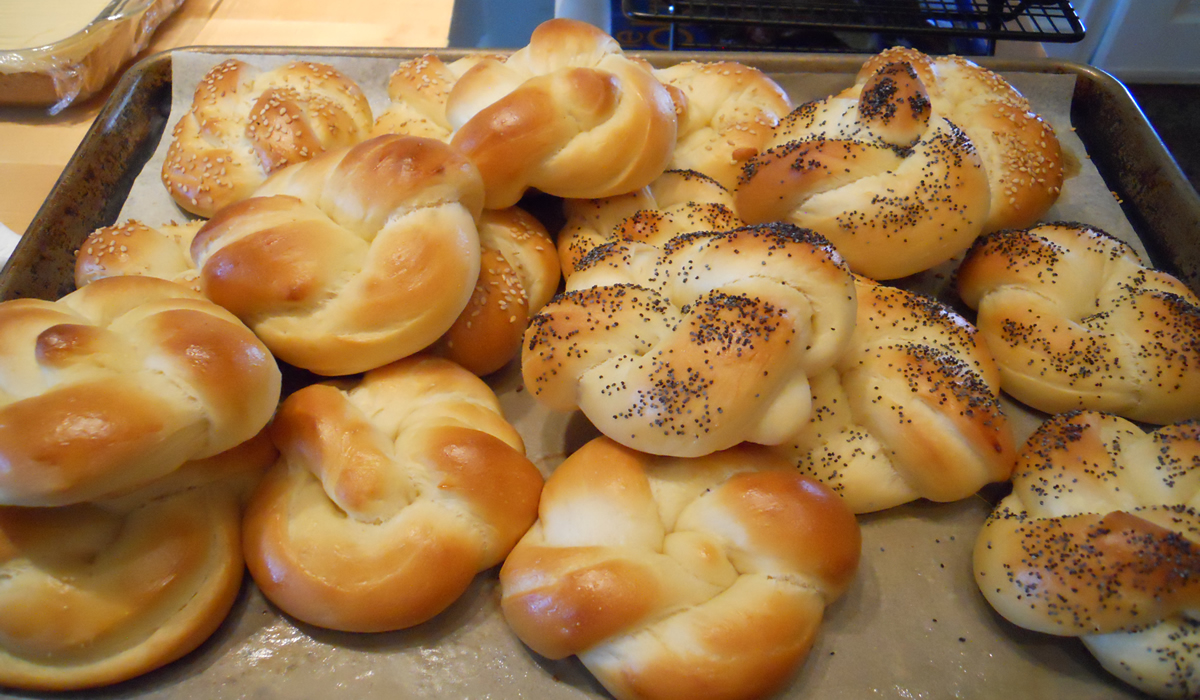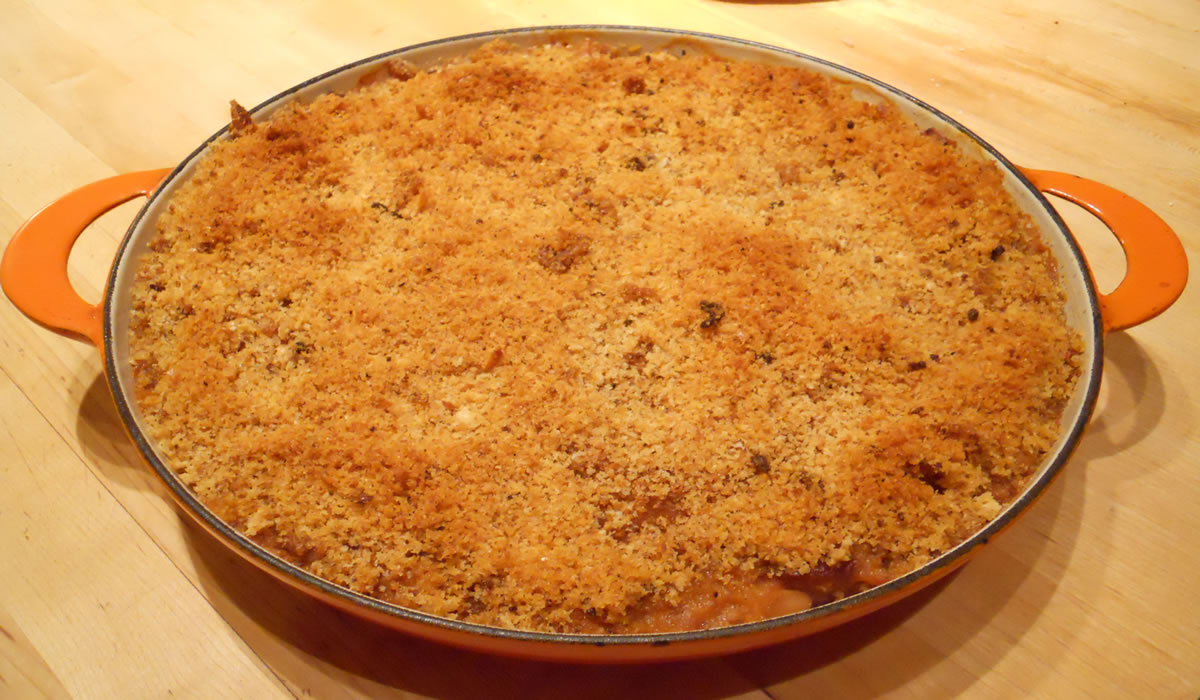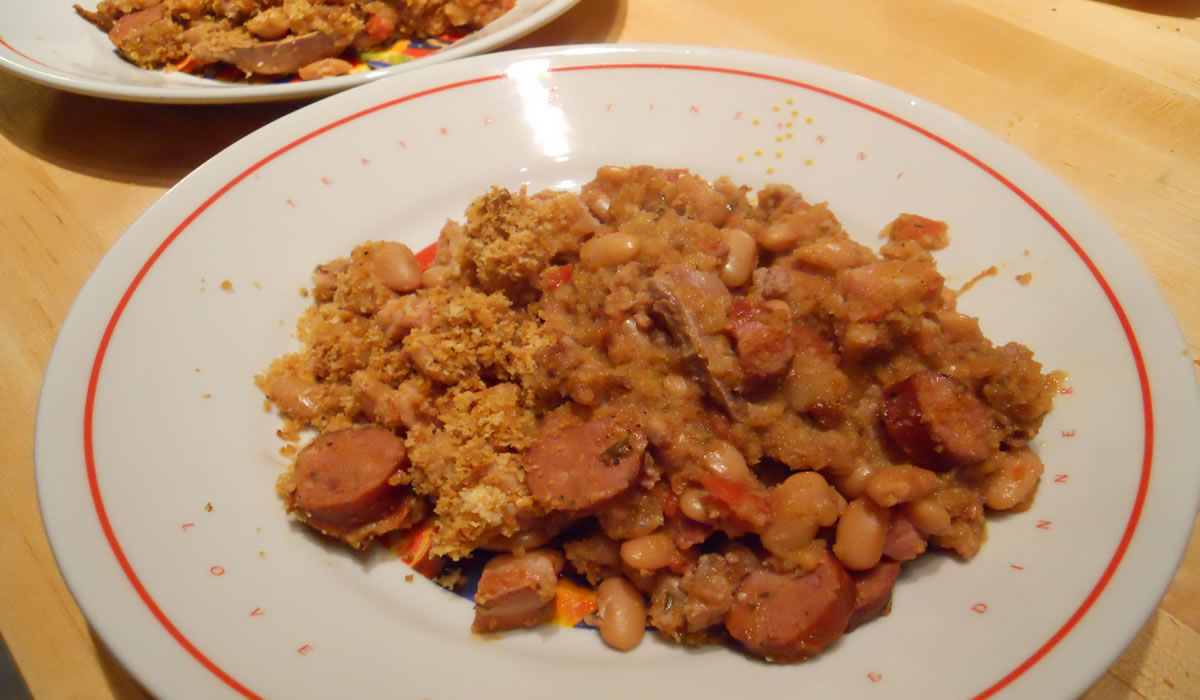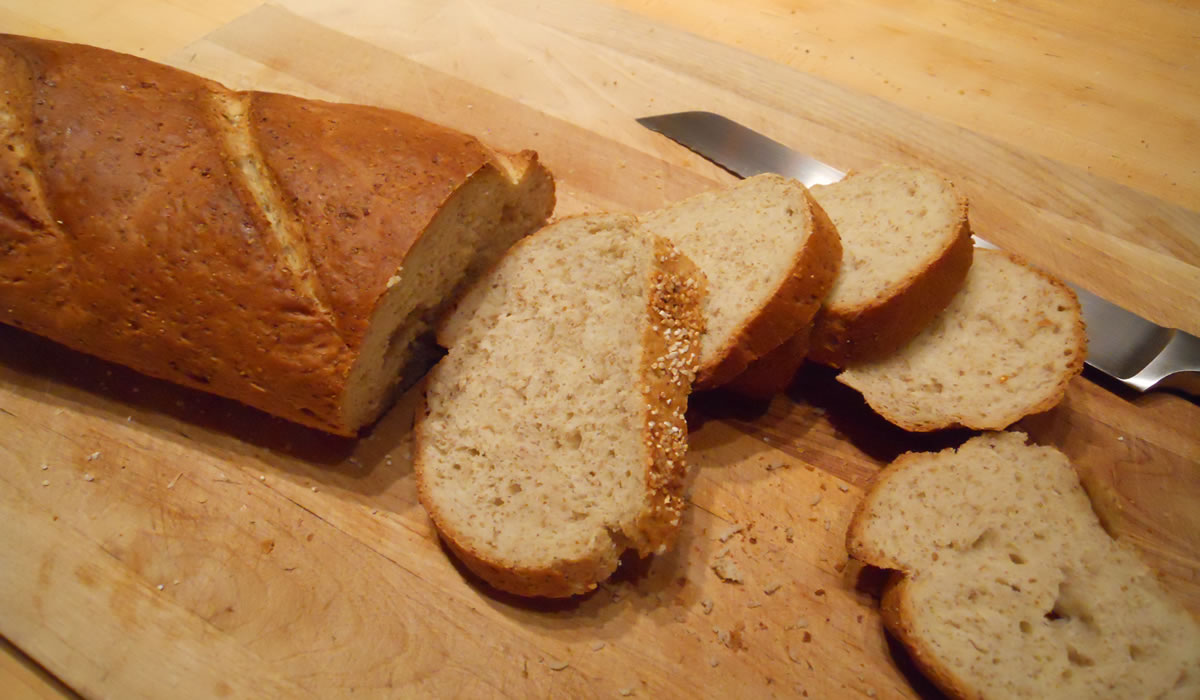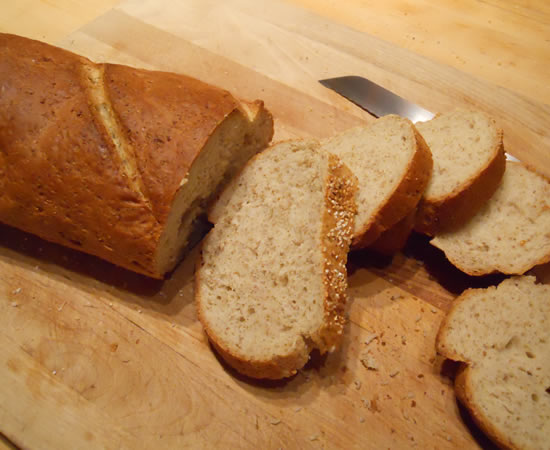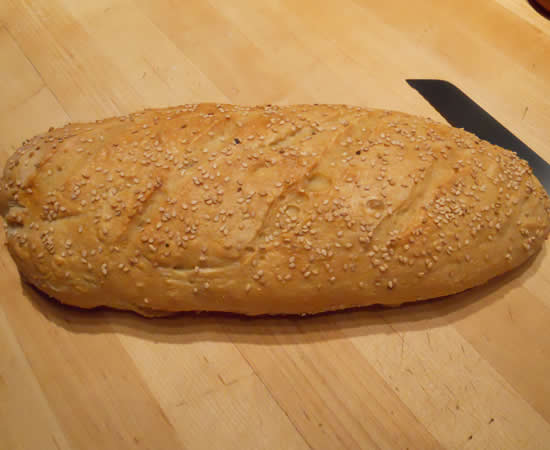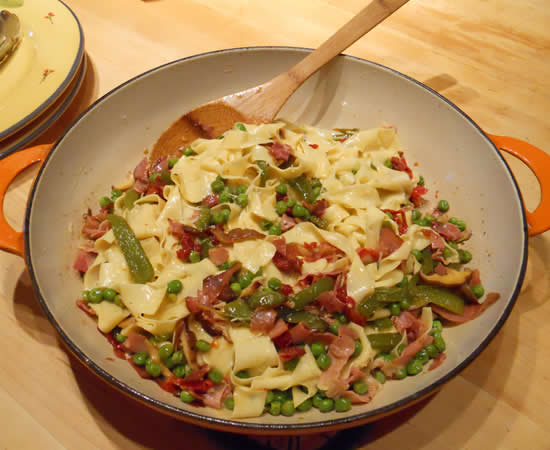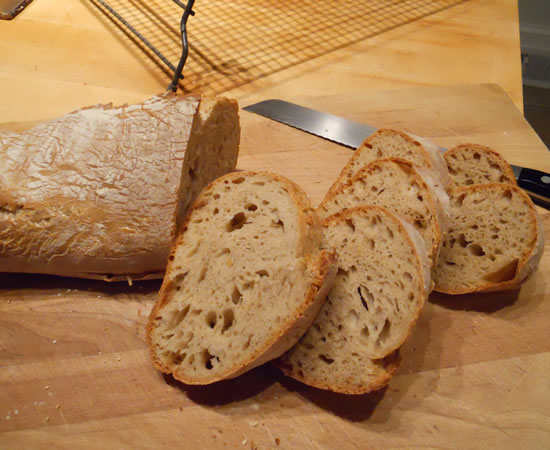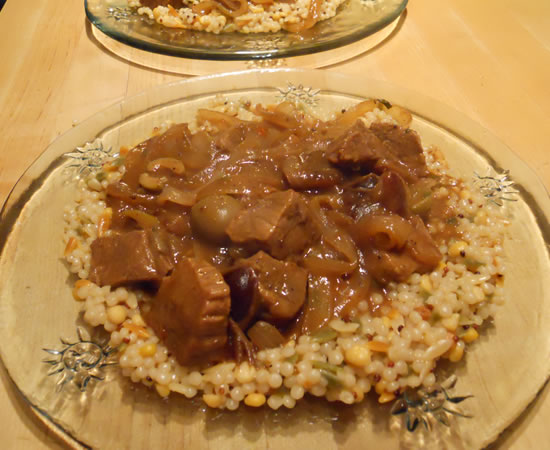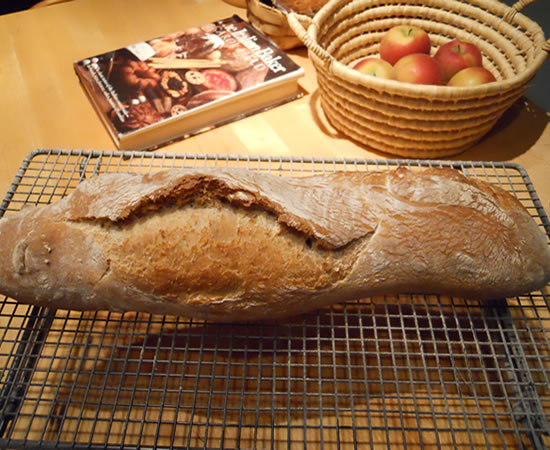Pasta and Fresh-Baked Bread
Pasta and fresh-baked bread two days in a row?!? You'd think I was married to an Italian. Oh. Wait. I am married to an Italian.
It started last might when I had to work late. I came home to bread fresh out of the oven and spaghetti with anchovies, sun-dried tomatoes, and crushed red pepper on the stove.
I swooned.
The pasta dish is nothing short of spectacular. Even folks who would never dream of eating an anchovy love this one. There's no fishy taste. It's just an explosion of flavor.
The basic is about a quarter-cup of olive oil in a skillet. Add a clove or two of minced garlic, and then maybe six anchovy fillets. The anchovies will pretty much dissolve into the oil. Add the sun-dried tomatoes, a hefty pinch of red pepper flakes, and a bit of black pepper.
Meanwhile, cook your pasta. Drain it, reserving a half-cup or so of the pasta water. Add the drained pasta to the sauce and mix well. Add a bit of the cooking water if the pan is too dry.
Stir in some freshly-grated parmesan or romano cheese, and mangia!
It is fresh-bread-dunking-good!
The bread is a James Beard loaf. It only proofs once, so it's one that can be on the table in just a couple of hours.
James Beard Bread
- 2 package of active dry yeast
- 1 tbsp sugar
- 2 tsp salt
- 1/4 cup olive oil
- 1 1/2 cups warm water (100-115 degrees)
- 3 to 3 1/2 cups all purpose flour
- 1 egg white beaten with 1T water
- course salt, sesame seeds, poppy seeds
In a large mixing bowl combine yeast and sugar. Let proof about 5 minutes. Add oil and 1/4 cup water. Mix.
Add salt. Add 1/2 cup of flour and continue mixing. Slowly add remaining flour.
Knead for several minutes until the dough springs back and is satiny and smooth. It is a fairly wet dough.
Form into a loaf about 20 to 22 inches long, let loaf rest about 20 minutes.
Brush lightly with egg wash and sprinkle with salt or seeds.
Bake in a 300° oven about 55 minutes.
Tonight, I had some chicken and decided I wanted ravioli - but not in a tomato sauce. A creamy red pepper sauce was what I came up with.
I sauteed two cut-up chicken breasts in a bit of olive oil. When they were partly done, I added two red peppers I had cut in strips. Next went a clove of minced garlic. When the chicken was cooked, I added about a half-cup of white wine and let it cook down. Next went a cup of chicken broth. When it was hot, I added about a half-cup of cream and about a cup of shredded assiago cheese. I then added about a teaspoon of Spanish paprika. We are the paprika kings with smoked Spanish paprika, Hungarian sweet paprika, Hungarian hot paprika, and Spanish sweet paprika. I thought sweet was best for this one...
A bit of black pepper, and then I thickened it with a pinch of cornstarch mixed with water.
I cooked up some cheese ravioli, mixed it all together, and called it dinner!
It came out really pretty - and tasted pretty good, as well. More of Victor's bread from last night and we had ourselves another feast!
Chicken Soup and Ciabatta
Tonight's dinner was brought to you by a magazine ad for an Italian Soup. I looked at it and realized I had a chicken, a package of tortellini, and a better grasp of Italian cooking than the folks who came up with the ad.
I follow guidelines for certain soups, as when I make Mulligatawny, but really... soup is throwing stuff in a pot. It ain't brain surgery and it ain't difficult.
Canned and packaged soups rely on chemicals and flavor-enhancers for taste. Unfortunately, a lot of people only relate to the trickery that food manufacturers use in their products and feel underwhelmed when they make things at home - not understanding that real food without additives tastes different - and better. It becomes a retraining of the taste buds to learn how good individual foods taste and how well different foods blend together.
That being said, soup is still throwing stuff into a pot. As much or as little as you like.
Bread - and baking - takes a bit more science.
I've actually never made a ciabatta bread before and was glad my first attempt was from a trusted source. I used a recipe from The Italian Baker by Carol Field. The dough is quite unlike most bread doughs and she stresses several times not to succumb and add more flour than called for. It was good advice that I'm sure I would not have followed from other cook books. But I've been baking breads from her book for years and know when to pay attention.
The dough is quite wet and sticky so it does not translate to making by hand. Use a mixer. And really resist adding more flour. Really.
The biga needs to set out for 12 hours, so start the day before you want the bread.
Ciabatta Bread
for biga:
- 1/8 tsp active dry yeast
- 1 cup water at room temp
- 1 1/4 cup all purpose flour
Dissolve yeast in water, add the flour and form a sticky dough. Leave it covered at room temperature for 16 to 24 hours.
for the final dough:
- 3 tbsp warm milk
- 1 tsp active dry yeast
- 2/3 cup water
- 1 tbsp olive oil
- 1 cup biga
- 2 cups all-purpose flour
- 1/2 tbsp salt
Using a mixer, stir the yeast in the milk and let it stand for a couple of minutes in the bowl. Add the water, oil, the biga, and mix to incorporate, dissolving the biga in the liquid. Add the flour and salt, and mix at low speed for a couple of minutes. Change to the dough hook and knead 2 minutes at low speed, and 2 minutes at medium speed. Finish kneading by hand on a well-floured surface, but adding as little extra flour as possible.
Place the dough in an oiled bowl, cover, and leave at room temperature for about 1 hour and 15 minutes. Divide the dough, which will be very soft and bubbly, in two equal pieces. Place each half on a well floured piece of parchment paper, and shape each as a cylinder, keeping the seam side down. Stretch it gently to give the ciabatta overall shape (a rectangle of 10 x 4 inches), and use the tip of your fingers to make deep dimples all over the dough. Cover with a damp towel and let them rise for about 1 1/2 hours - not quite doubled in size.
Preheat oven to 425° with a baking stone. Right before placing the dough in, dust the stone with cornmeal. Gently roll the breads from the parchment onto the stone. Bake until the breads are golden brown, about 25 minutes, spraying them with water a few times during the first 10 minutes. Cool on racks.
I made chicken salad sandwiches with one of the loaves. You can get quite a few meals with a chicken and a bit of flour...
Soup and Sandy
Fresh-baked bread and a pot of soup simmering on the stove are two of the better ways to hunker down during a storm. We've used up just about every cliché we can think of, and I swear I really need to get that damned "The wind began to switch - the house to pitch and suddenly the hinges started to unhitch..." out of my head. That, Lena Horne singing Stormy Weather, and Jim Morrison singing Riders on the Storm.... The iPod of my mind is going into overdrive...
But while all that is going through my head, bread and soup are being prepared. We're going to eat well, dammit!
It really is starting to get nasty outside. It's following the timeline Victor found this morning pretty closely. I just keep hoping the power stays on.
But, if it doesn't we shall survive.
The bread is James Beard's French Bread. It is one of the most easy breads to bake. The soup is soup. Stuff in a pot.
James Beard French-Style Bread
Ingredients
- 1 package active dry yeast
- 2 tsp sugar
- 1 cup warm water (100° to 115°, approximately)
- 1 1/2 tsp salt
- 3 cups flour
- 3 tablespoons yellow cornmeal
Directions
Combine the yeast with sugar and warm water in a large bowl and allow to proof. Mix the salt with the flour and add to the yeast mixture, a cup at a time, until you have a stiff dough. Remove to a lightly floured board and knead until no longer sticky, about 10 minutes, adding flour as necessary. Place in a buttered bowl and turn to coat the surface with butter. Cover and let rise in a warm place until doubled in bulk, 1½ to 2 hours.
Punch down the dough. Turn out on a floured board and shape into a long, French bread-style loaf. Place on a baking sheet that has been sprinkled with the cornmeal but not buttered. Slash the tops of the loaf diagonally in two or three places. Place in a cold oven, set the temperature at 400° and bake 35 minutes or until well browned and hollow sounding when the top is rapped.
I'm making sauce next and we'll have manicotti and sausages in a meat sauce for dinner. Victor's mom is staying with us so we need to have meals that are a bit more structured.
Mother Nature is having a ball. We're eating well. Not bad.
Beef Soup and Beer Bread
Last night was chicken soup and cornbread Tonight is beef soup and beer bread. With this %$@#& cold I have, the only thing that remotely sounds good is soup. I can throw stuff in a pot and walk away. Anything else is just too much of an effort.
It's not that I'm sick-sick, just snotty and tired. And Victor has started with a scratchy throat, too. This is just not the way to start the Storm of the Century.
The soup had a bit of everything in it:
- beef
- Mexican chorizo sausage
- canned tomatoes
- beef broth
- fresh longhorn peppers
- onions
- garlic
- great northern beans
- pinto beans
- black beans
- pink beans
- pimentos
- canned green chilis
- carrots
- salt & pepper
The combination of ingredients added all the herbs and spices it needed. I didn't add anything. It was mildly spicy and really rich. I let it boil for a while to reduce a bit.
The beer bread was my old standby. And I used up my last bottle of beer! Time to get more before the end of the world hits Sunday night.
This is truly one of the easiest breads to make - and it really does taste good.
Quick Beer Bread
- 3 cups self-rising flour
- 2 tbsp sugar
- 12 oz beer
- Melted butter
Mix and put into a 4″ x 8″ bread pan. Top with melted butter. Bake at 350° about 1 hour.
At least we're eating well... I have at least one more day of trying to get over this damned cold before returning to work...
Time for a cup of tea...
Pane di Como Antico
Last week when I baked my Pane Pugliese, I split the biga into several baggies and froze it for later use. I pulled one out of the freezer last night 'cuz I planned on making a loaf today. All seemed well... I chose Pane di Como Antico from Carol Field's Italian Baker cook book and bright and early, started making the bread.
The house was a bit chilly and I wasn't really concerned about the time it was taking to rise, since a slow, cool rise really makes for a more developed bread. But when it hadn't budged after 4 hours, I knew there was a problem. Back into the mixer it went, along with a pinch of yeast, and into a warm room.
While I'm not sure what the end result is supposed to be, I ended up with a really good loaf of bread!
A nice chewy crust and a nicely-textured crumb made for a great accompaniment to dinner!
Sadly, I had to throw out the remaining biga in the freezer. But... I'll make more! The biga needs to be made the day before you make the bread!
Another note is Carol Field specifies 1/4 cup of whole wheat flour but I like the flavor of rye flour, so I tend to use it when adding under a cup to a recipe.
Pane di Como Antico
adapted from The Italian Baker by Carol Field
Biga
- 1/4 tsp active dry yeast
- 1/4 cup warm water
- 1 1/4 cup water (room temperature)
- 3 3/4 cups unbleached all-purpose flour
Stir the yeast into the warm water and let stand until creamy – about 10 minutes. Stir in the remaining water and then the flour, one cup at a time.
Mix with the paddle attachment on the mixer at the lowest speed about 2 minutes.
Remove to a slightly oiled bowl, cover, and let rise at cool room temperature for 6 to 24 hours. The starter will triple in volume and still be wet and sticky when ready. Cover and refrigerate until ready to use.
Bread
- 3/4 c biga
- 3/4 cup water; At Room Temperature
- 1/4 cup rye flour
- 1 1/2 cups all-purpose flour
- 1 tsp salt
- Cornmeal
Mix the starter and water with the paddle in a large mixer bowl. Mix in the flours and salt. Switch to the dough hook and knead until softy and elastic, about 4 minutes. Finish kneading by hand on a lightly floured surface, sprinkling with additional flour, until smooth but still soft.
First Rise:
Place the dough in a lightly oiled bowl, cover with plastic wrap, and let rise until doubled, 1 1/2 to 2 hours. The dough is ready when it has numerous bubbles and blisters under the skin.
Shaping and Second Rise:
Divide the dough in half on a lightly floured surface without kneading it. Shape into a round loaf. Let it relax under a cloth for 20 minutes. Line baking sheet or peel with parchment paper and flour the paper generously. Roll ball into a fat cylinder and place seam side down on the paper. Dimple the loaf all over with your fingertips or knuckles, as for focaccia, to keep the dough from springing up. The dough should feel delicate but extremely springy.
Cover the loaf and let rise until doubled, with many visible air bubbles, 1 1/4 to 1 1/2 hours.
Baking:
Thirty minutes before baking, heat the oven with a baking stone in it to 425° . Sprinkle the baking stone with cornmeal. Very gently invert the dough onto the stone. Gently remove the parchment paper. Immediately reduce the heat to 400° and bake until golden, 35 to 40 minutes. Cool on wire rack.
Homemade Bread and Soup
The weather was juuuuust cool enough yesterday to warrant a pot of soup and a loaf of bread. Every season has its food benefits, but Fall has soups and stews - some of my favorite things. Soups around here are clean-out-the-refrigerator meals, for the most part. While I do have a few soups that call for specific ingredients, they usually are concoctions of what is in the house. They're fun, because they're never quite the same from batch to batch.
I strained that big batch of pumpkin puree and had close to a quart of pumpkin juice left. (I drained it overnight in a cheesecloth-lined colander.) That went into the broth right off the bat. Along with some beef, beef broth, carrots, rice, black and white barley, celery, beans, tomatoes, cauliflower, garlic, spinach, yellow hominy, and pasta. I added a bit of French herbs, salt, and pepper.
It came out great.
And then we had a great loaf of bread...
It's a really easy James Beard recipe I've used for years. And years. Really versatile, I braided this loaf and added the sesame seeds.
James Beard French-Style Bread
Ingredients
- 1 package active dry yeast
- 2 tsp sugar
- 1 cup warm water (100° to 115°, approximately)
- 1 1/2 tsp salt
- 2 1/2 cups bread flour
- 1/2 cup rye flour
- 3 tablespoons yellow cornmeal
- 1 egg white, mixed with 1 tablespoon cold water
Directions
Combine the yeast with sugar and warm water in a large bowl and allow to proof. Mix the salt with the flour and add to the yeast mixture, a cup at a time, until you have a stiff dough. Remove to a lightly floured board and knead until no longer sticky, about 10 minutes, adding flour as necessary. Place in a buttered bowl and turn to coat the surface with butter. Cover and let rise in a warm place until doubled in bulk, 1½ to 2 hours.
Punch down the dough. Turn out on a floured board and shape into a long, French bread-style loaf. Place on a baking sheet that has been sprinkled with the cornmeal but not buttered. Slash the tops of the loaf diagonally in two or three places, and brush with the egg wash. Place in a cold oven, set the temperature at 400°, and bake 35 minutes, or until well browned and hollow sounding when the top is rapped.
It takes no time at all to make and always is a hit!
I see a lot more of this in our future...
Bread and Rolls
What's the old adage... When life hands you lemons, make lemonade?!? That's kinda how today is...
We had plans for a fun day with friends and Victor threw his back out last night. Not good. And definitely not up for an hour drive in the car.
Regroup.
Now having to plan a couple of meals I wasn't planning on cooking, I took stock of the larder; plenty of food, lots of sandwich-fixin's - but no bread. My choice was to drive the mile to the grocery store and buy a loaf - or bake some. It's not everyone who will think it's easier to bake a loaf of bread than run to the store, but, for me, not having to deal with a grocery store on a Saturday is a good thing. Besides, have you ever looked at the ingredient list on a basic loaf of grocery store bread?!? Yuck.
So out came Mom's trusty cook book.
She had a recipe for a basic wheat bread that I default to whenever I want a quick couple of loaves. It is really good, really easy, and pretty quick to pull together. I really haven't been making a lot of loaves of bread, lately. They have been mostly free-form rustic breads. I thought it time to break out the loaf pans and have at it.
The recipe calls for two loaves and I knew we'd never go through them before it went stale, so I decided one loaf and a few rolls would work.
I started the process, went to get the whole wheat flour - and noticed there wasn't any! I had rye, buckwheat, graham, whole wheat pastry, and unbleached cake, all-purpose, and bread flours. No whole wheat. Whole wheat bread became white bread. I'll live with it.
I followed the recipe as written, except I used the bread flour and omitted the egg.
I baked the rolls for about 20 minutes and the bread for maybe 38 minutes. It also rose a lot faster today than usual - white flour will generally rise quicker than a more-dense wheat, anyway - but it's hot and muggy outside... the perfect summer proofing box.
It all came out great. Perfectly light, really flavorful, lots of body - and the long rolls were perfect for leftover sausage and peppers.
A Basket of Italian Rolls
I picked up an old copy of La Cucina Italiana the other day, and marveled at all the things I hadn't yet made. So many recipes, so little time.
But last night, after getting home late from having dinner with friends, I made a poolish for some herbed rolls. I'm off on Monday and have the time to play in the kitchen a bit more...
A poolish - for those who are not Italian or French bakers - is another name for a starter. It's a bit wetter than a biga - which is also a starter. It's flour, water, and a pinch of yeast left out overnight - a pre-fermentation starter.
And since I had two bags of Italian "00" flour, out it came.
I had to play with the recipe a bit because my flour was much drier than a basic all-purpose, but the rolls came out pretty good. In fact, Victor ate one as a sandwich for lunch and raved about it. And then had another with dinner - along with more raves.
Panini con erbe aromatiche
Herb Bread Rolls
adapted from La Cucina Italiana MagazineIngredients
Poolish
- 1 cup unbleached all-purpose flour
- 1/2 cup tepid water
- 1/2 teaspoon active dry yeast
Dough
- 3 1/2 cups unbleached all-purpose flour plus more for dusting
- 3/4 cup plus 1 1/2 tablespoons warm water
- 2 tablespoons extra-virgin olive oil
- 1 teaspoon fine sea salt
- 1 3/4 teaspoons finely chopped mixed herbs, such as oregano, rosemary and thyme
Instructions
Poolish: In a bowl, stir together flour, water and yeast. Let mixture stand at room temperature at least 10 hours or overnight.
Dough: Add flour, water, oil and salt to poolish; mix together to form dough. Turn out dough onto a clean surface and knead until smooth and elastic, about 5 minutes.
Stretch and pat out dough into a 10-inch square and sprinkle with herbs. Knead, 1 minute, to incorporate herbs. Form dough into a ball, then transfer to a large bowl. Cover bowl with a clean, damp dishtowel and let dough rise, in a draft-free place at warm room temperature, until doubled in bulk, about 1 hour.
Spread a clean, dry dishtowel on work surface. Dust work surface and dishtowel with flour. Divide dough into 12 equal pieces; roll each piece into a ball. Cover balls with a clean damp dishtowel and let rest, 10 minutes. On work surface, stretch one ball into a 2- x 8-inch rectangle. With short side of rectangle facing you, fold bottom edge to center, then fold top edge to center. Press firmly with fingertips to seal seams, then fold in half, folding bottom edge over top. Pinch together all seams, then gently roll dough to create a 5-inch-long loaf.
With the edge of your hand, firmly press center of loaf to create a deep indentation. Transfer loaf to prepared dishtowel. Repeat with remaining dough. Sprinkle flour over indentations, then cover loaves with a second clean, dry dishtowel. Let rise, in a draft-free place at warm room temperature, 25 minutes.
Heat oven to 450° with rack in middle. Line two baking sheets with parchment paper. Arrange loaves on baking sheets. One batch at a time, bake rolls until deep golden, about 20 minutes. Let rolls cool on a wire rack at least 10 minutes before serving.
I used fresh thyme and oregano and the herb flavor was barely perceptible. You could easily go for a full tablespoon of minced fresh herbs with no problem.
But the rolls, themselves were really good. They shall stay in the repertoire!
Knotted Dinner Rolls
I have been looking at this recipe for six months telling myself I have to make these.
I am so sorry I waited so long!
They are from Fine Cooking magazine. And it is rapidly becoming my favorite cooking magazine!
These may just be the best - and easiest - dinner rolls I have ever made. They are light, airy, flavorful... In a word... perfect.
I followed the recipe exactly and they came out exactly as pictured. These will definitely be my "go-to" dinner roll from now on.
Knotted Dinner Rolls
by Peter Reinhart
For the dough
- 1-1/2 cups whole milk; more as needed
- 1 packet (1/4 oz. or 2-1/4 tsp.) instant or active dry yeast
- 1/4 cup vegetable oil; more as needed
- 1 oz. (2 Tbs.) unsalted butter
- 1/4 cup granulated sugar
- 1 lb. 7 oz. (5-1/4 cups) unbleached bread flour; more as needed
- 1-1/4 tsp. table salt or 2 tsp. kosher salt
- 1 large egg
For shaping and baking
- Vegetable oil spray
- 1 large egg
- Poppy or sesame seeds for garnish (optional)
Make the dough
In a small saucepan, heat the milk until lukewarm (about 95°F). Remove from the heat and whisk in the yeast until it dissolves. Add the oil and butter—the butter may begin to melt, but it’s OK if it doesn’t melt completely—and then whisk in the sugar. Let rest until the yeast just begins to float to the surface, about 5 minutes.
In a stand mixer fitted with the paddle attachment (or in a large bowl), combine the flour, salt, and egg. Add the yeast mixture and mix on low speed (or with a large spoon) until a coarse ball of dough forms, about 1 minute. Let rest for 5 minutes.
Replace the paddle attachment with the dough hook and mix on medium-low speed (or knead by hand on a lightly oiled work surface) until the dough feels soft, supple, and pliable, about 3 minutes; it should feel tacky to the touch, but not sticky, and pull away from your finger when poked instead of sticking to it. If the dough is too sticky, add 1 Tbs. flour at a time, kneading to incorporate. If it’s stiff, knead in 1 Tbs. of milk at a time.
Rub a little vegetable oil on a work surface to create an 8-inch circle and put the dough on this spot. Stretch and fold the dough over itself from all four sides to the center, crimping it where the folded ends meet, to form it into a tight, round ball.
Put the dough seam side down in a lightly oiled bowl that’s twice the size of the dough. Tightly cover with plastic wrap. Let sit at room temperature until doubled in size, about 90 minutes.
Shape the rolls
Tip: Need help shaping your rolls? Check out our step-by-step guide on how to shape knotted dinner rolls.
Line two 13x18-inch rimmed baking sheets with parchment or nonstick baking liners and lightly mist them with vegetable oil spray.
Using a bench knife, divide the dough into eighteen pieces (about 2-1/4 oz. each).
With your hands, roll one piece into a 12-inch-long rope. If the dough starts to stick, mist your work surface lightly with vegetable oil spray or wipe it with a damp towel. Don’t use flour.
Wrap the dough around your fingers into a loose knot; there should be about 2 inches of dough free at each end. Wrap the left end of the dough up and over the loop. Wrap the right end down and under the loop. Lightly squeeze the two ends of dough together in the center to secure them.
Gently squeeze the whole piece of dough into a nice rounded shape. Put the roll, pretty side up, on a baking sheet. Repeat with the remaining dough. Mist the top of the rolls with vegetable oil spray and cover loosely with plastic wrap.
Let the rolls sit at room temperature or refrigerated until they just begin to swell, 30 minutes to 1 hour for room-temperature dough, 1 to 1-1/2 hours for refrigerated dough.
Bake the rolls
Position racks in the upper and lower thirds of the oven. If using a convection oven, heat it to 375°F; if using a conventional oven, heat it to 400°F.
Thoroughly whisk the egg with 1 Tbs. water and brush all over each roll. Sprinkle poppy or sesame seeds (if using) on the rolls.
While the oven heats, let the rolls continue to rise at room temperature, 20 to 40 minutes. They should be 1-1/2 to 2 times their original size before they go in the oven. (Once in the oven, they will rise about 20 percent more.)
Put the baking sheets in the oven and bake for 6 minutes. Rotate the sheets 180 degrees and swap their placement on the racks. Continue baking until the rolls turn rich golden-brown on top and develop some browning underneath, another 6 to 8 minutes. Let the rolls cool on the sheets or on a cooling rack for 15 minutes before serving.
Make Ahead Tips
You can make the dough up to 4 days ahead. Refrigerate it well wrapped so that it slowly rises to double its size then shape as directed.
nutrition information (per serving):
Calories (kcal): 210; Fat (g): 7; Fat Calories (kcal): 60; Saturated Fat (g): 2; Protein (g): 6; Monounsaturated Fat (g): 2.5; Carbohydrates (g): 30; Polyunsaturated Fat (g): 2; Sodium (mg): 180; Cholesterol (mg): 25; Fiber (g): 1;
photo: Scott Phillips
From Fine Cooking 113 , pp. 60-63
September 1, 2011
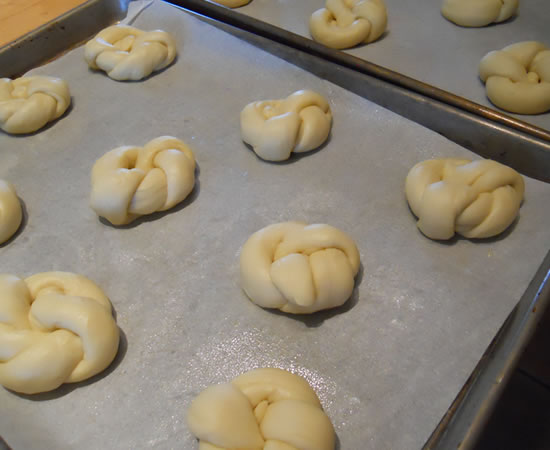
I brushed them with the egg wash and made 6 poppy seed, 6 sesame seed, and 6 plain. They take no time at all and really are just too good to be true!
Cassoulet and Fresh-Baked Bread
I have been thinking about a cassoulet for months. A real cassoulet - with duck confit and everything.
Today, I made my cassoulet!
In its most base form, a cassoulet is French baked beans. But - in true French style - the lowly bean is elevated to dizzying gastronomical heights.
It is a treat, indeed.
There are probably as many recipes for cassoulet in France as there are ravioli in Italy, so I didn't feel the need to strictly follow any one recipe. I went for a bit more technique than strict ingredients, but the end result was just fine.
The recipe here is from Gourmet magazine from about 10 years ago. I changed it by using canary beans instead of white, adding about 8 ounces of Ventreche - French pancetta - and only using one duck leg. I also cut the water back to 5 cups to start, along with the 2 cups of broth. I didn't have any parsley, either, and didn't feel like getting dressed and going to the store. (Damned cold!!)
But parsley or no, it came out just fine.
Cassoulet
- 1 lb dried white beans (preferably Great Northern)
- 8 1/4 cups cold water
- 2 cups beef broth
- 1 tablespoon tomato paste
- 2 cups chopped onion (3/4 lb)
- 3 tablespoons finely chopped garlic (6 large cloves)
- 1 (3-inch) piece celery, cut into thirds
- 3 fresh thyme sprigs
- 1 Turkish or 1/2 California bay leaf
- 3 whole cloves
- 3 fresh flat-leaf parsley sprigs plus 1/2 cup chopped leaves
- 1/4 teaspoon whole black peppercorns
- 1 (14-oz) can stewed tomatoes, puréed or finely chopped with juice
- 4 confit duck legs (1 3/4 lb total)
- 1 to 2 tablespoons olive oil (if necessary)
- 1 lb cooked garlic pork sausage* or smoked pork kielbasa, cut crosswise into 1/3-inch-thick slices
- 2 cups coarse fresh bread crumbs (preferably from a baguette)
- 1 1/2 teaspoons salt
- 1/2 teaspoon black pepper
preparation
Soak and cook beans
Cover beans with cold water by 2 inches in a large bowl and soak 8 to 12 hours. Drain in a colander.
Transfer beans to a 6- to 8-quart pot and bring to a boil with 8 cups cold water, broth, tomato paste, onion, and 2 tablespoons garlic. Put celery, thyme, bay leaf, cloves, parsley sprigs, and peppercorns in cheesecloth and tie into a bundle with string to make a bouquet garni. Add bouquet garni to beans, then reduce heat and simmer, uncovered, until beans are almost tender, 45 minutes to 1 hour. Stir in tomatoes with juice and simmer until beans are just tender, about 15 minutes more.
Prepare duck and sausage while beans simmer:
Remove all skin and fat from duck legs and cut skin and fat into 1/2-inch pieces. Separate duck meat from bones, leaving it in large pieces, and transfer meat to a bowl. Add bones to bean pot.
Cook duck skin and fat with remaining 1/4 cup cold water in a 10-inch heavy skillet over moderate heat, stirring, until water is evaporated and fat is rendered, about 5 minutes. Continue to cook, stirring frequently, until skin is crisp, 3 to 6 minutes more. Transfer cracklings with a slotted spoon to paper towels to drain, leaving fat in skillet. (You should have about 1/4 cup fat; if not, add olive oil.)
Brown sausage in batches in fat in skillet, then transfer to bowl with duck meat, reserving skillet.
Preheat oven to 350°F.
Make bread crumb topping:
Add remaining tablespoon garlic to fat in skillet and cook over moderate heat, stirring, 1 minute. Stir in bread crumbs and cook, stirring, until pale golden, about 2 minutes. Remove from heat and stir in chopped parsley, 1/2 teaspoon salt, 1/4 teaspoon pepper, and cracklings.
Assemble casserole:
Remove bouquet garni and duck bones from beans and discard, then stir in kielbasa, duck meat, remaining teaspoon salt, and remaining 1/4 teaspoon pepper.
Ladle cassoulet into casserole dish, distributing meat and beans evenly. (Meat and beans should be level with liquid; if they are submerged, ladle excess liquid back into pot and boil until reduced, then pour back into casserole dish.) Spread bread crumb topping evenly over cassoulet and bake, uncovered, in lower third of oven, until bubbling and crust is golden, about 1 hour.
It really worked on every level. Rich, flavorful, creamy, meaty, and filling. I was surprised at just how much duck meat was on that one leg and I still got a fair amount of cracklin's for the bread crumbs. More would have been nice - but what I had worked.
And a big cassoulet called for a fresh loaf of bread. I went to my lazy-man's loaf - James Beard's French Loaf - his Cuban bread. I tweaked it a bit and added a bit of rye flour . Came out excellent!
His original recipe makes two loaves. I cut it down for one.
James Beard French-Style Bread
Ingredients
- 1 package active dry yeast
- 2 tsp sugar
- 1 cup warm water (100° to 115°, approximately)
- 1 1/2 tsp salt
- 2 1/2 cups bread flour
- 1/2 cup rye flour
- 3 tablespoons yellow cornmeal
- 1 egg white, mixed with 1 tablespoon cold water
Directions
Combine the yeast with sugar and warm water in a large bowl and allow to proof. Mix the salt with the flour and add to the yeast mixture, a cup at a time, until you have a stiff dough. Remove to a lightly floured board and knead until no longer sticky, about 10 minutes, adding flour as necessary. Place in a buttered bowl and turn to coat the surface with butter. Cover and let rise in a warm place until doubled in bulk, 1½ to 2 hours.
Punch down the dough. Turn out on a floured board and shape into a long, French bread-style loaf. Place on a baking sheet that has been sprinkled with the cornmeal but not buttered. Slash the tops of the loaf diagonally in two or three places, and brush with the egg wash. Place in a cold oven, set the temperature at 400°, and bake 35 minutes, or until well browned and hollow sounding when the top is rapped.
I do have to admit that we ate well, tonight.
Now... if this damned cold would just go away...
Tagliatelle Fresche and Fresh-Baked Bread
It's another Saturday and I came home to another feast! Homemade pasta and homemade bread. It just doesn't get any better!
The pasta was Victor's famous tagliatelle. The bread was from James Beard.
The pasta is so light but so full of flavor and texture. It can withstand any type of sauce, but I just love it when Victor grabs whatever out of the 'fridge and creates! Tonight he took olive oil, sun-dried tomatoes in oil, oyster mushrooms, bell pepper, peas, and prosciutto, sauteed it all and then stirred in the cooked pasta and sprinkled some freshly-grated cheese on top.
Did I mention perfection?!?
Perfection.
This is a half-batch of the pasta recipe.
Tagliatelle Fresche
Ingredients
- 1 cup unbleached all-purpose flour
- 1 large egg
- 1 large egg yolk
- Coarse sea salt
Instructions
On a clean work surface, mound flour and form a well in the center. Add egg and egg yolk to the well. Using a fork, gently break up yolks and slowly incorporate flour from inside rim of well. Continue until liquid is absorbed, then knead for 10 minutes. Wrap dough tightly in plastic and let rest for 30 minutes.
Divide dough into 3 pieces. Cover 2 pieces with plastic wrap. Flatten remaining dough piece so that it will fit through the rollers of a pasta machine.
Set rollers of pasta machine at the widest setting, then feed pasta through rollers 3 or 4 times, folding and turning pasta until it is smooth and the width of the machine.
Roll pasta through machine, decreasing the setting, one notch at a time (do not fold or turn pasta), until pasta sheet is scant 1/16 inch thick.
Cut sheet in half widthwise; dust both sides of sheets with flour. Layer sheets between floured pieces of parchment or wax paper. Cover with paper and repeat with remaining dough.
With the short end of 1 pasta sheet facing you, loosely fold up sheet, folding sheet over two or three times from short ends toward the center. With a large chefs knife, cut folded sheet into ribbons, a scant 1/4 inch wide. Unroll strips and lightly dust with flour; spread on a lightly floured baking sheet. Repeat with remaining pasta sheets.
To cook the tagliatelle, bring a large pot of salted water to a boil. Add pasta and cook until tender, about 3 minutes. Drain pasta, transfer to a large serving bowl and toss with sauce.
And then, just because perfect pasta wasn't enough, he made a loaf of one of my favoriote breads!
This comes from the Beard on Bread cook book by James Beard. It's quick and reasonably difficult to screw up!
James Beard French-Style Bread
- 1 1/2 pk active dry yeast
- 1 tbsp sugar
- 2 cups warm water (100-115 deg.)
- 1 tbsp salt
- 5-6 cups all-purpose or hard wheat flour
- 3 tbsp Yellow cornmeal
- 1 egg white mixed with 1 tbsp cold water
Combine the yeast with sugar and warm water in a large bowl and allow to proof. Mix the salt with the flour and add to the yeast mixture, a cup at a time, until you have a stiff dough.
Remove to a lightly floured board and knead until no longer sticky, about 10 minutes, adding flour as necessary.
Place in a buttered bowl and turn to coat the surface with butter. Cover and let rise in a warm place until doubled in bulk..1 1/2-2 hrs.
Punch down the dough. Turn out on a floured board and shape into two long, French bread-style loaves. Place on a baking sheet that has been sprinkled with the cornmeal, but NOT buttered.
Slash the tops of the loaves diagonally in two or three places with a single edge razor blade or sharp knife, brush the loaves with the egg white wash.
Place in a COLD oven, set the temperature at 400° and bake 35 minutes, or until well browned and hollow sounding when the tops are tapped.
The meal was perfection all the way.
Bread and Beef
Tonights dinner came about courtesy of Cooking Light magazine.
I've subscribed to Cooking Light on and off for years. It can be good for ideas now and again and it can have some useful information now and again, but I rarely actually follow any of the recipes.
Nothing unusual in that as I rarely follow any recipes...
We had some dates in the 'fridge that needed using up and this months issue had a recipe for chicken and dates. The Cooking Light recipe, printed below, really sounded fun. Problem was, I didn't have any chicken. But I had some beef. Not having an ingredient has never been a good reason not to make something.
A recipe was born!
Chicken with Dates, Olives, and Cinnamon
David Bonom, Cooking Light
October 2011Ingredients
- 12 bone-in chicken thighs, skinned
- 1/4 teaspoon freshly ground black pepper
- 1/8 teaspoon kosher salt
- 2 tablespoons butter, divided
- 2 tablespoons olive oil, divided
- 4 cups sliced onion
- 1 teaspoon minced peeled fresh ginger
- 18 pitted manzanilla (or green) olives, chopped
- 2 tablespoons all-purpose flour
- 3/4 teaspoon ground cumin
- 1/2 teaspoon ground coriander
- 1/8 teaspoon ground red pepper
- 1 (3-inch) cinnamon stick
- 2 cups fat-free, lower-sodium chicken broth
- 1/2 cup whole pitted dates, chopped
- 3 tablespoons fresh lemon juice
- 1/4 cup fresh basil leaves
Preparation
- Sprinkle chicken with pepper and salt. Melt 1 tablespoon butter in a 10-quart Dutch oven over medium-high heat. Add 1 tablespoon oil to pan; swirl to coat. Add 6 chicken thighs to pan; cook 4 minutes on each side or until browned. Remove chicken from pan. Repeat with remaining 1 tablespoon butter, remaining 1 tablespoon oil, and remaining 6 chicken thighs.
- Add onion and ginger to pan; sauté 8 minutes, stirring frequently. Add olives; sauté for 1 minute. Add flour and the next 4 ingredients (through cinnamon stick); cook 1 minute, stirring constantly. Add broth; bring to a boil, scraping pan to loosen browned bits. Cook for 1 minute. Return chicken to pan. Cover, reduce heat to low, and cook 12 minutes. Stir in dates; simmer 10 minutes or until chicken is done. Stir in juice, and garnish with basil.
I more or less followed the recipe, substituting cubed beef for the chicken thighs and beef broth for the chicken broth. The spices worked perfectly with the beef - and I'm sure they'd work equally well with just about anything. It was rich without being overpowering.
Of course, what started the whole stew-ish dinner idea was that I wanted to bake a loaf of bread. I still have starter from my last pugliese loaf and thought a cruisty loaf of something would be the perfect way to enjoy this slightly-chilly day.
What I didn't expect was for it to literally be an all-day event.
This particular bread calls for a biga - a starter - but doesn't call for any more yeast - as do most other breads. Since I was starting out with a refrigerated starter and the house wasn't exactly hot, it took several hours for the various risings to happen. But it was worth the time!
Pane Di Como Antico
Carol Field The Italian Baker
- 3/4 c Biga
- 1 1/2 cups water at room temperature
- 1/2 cup Whole wheat flour
- 3 cups To 3 3/4 cups unbleached all purpose flour
- 2 tsp salt
- Cornmeal
Cut the starter into small pieces in a large mixing bowl. Add all but 1 to 2 Tbsp. of the water and mix until the starter is in fine shreds and the liquid is chalky white. Stir in the whole wheat flour and most of the all-purpose flour, 1 cup at a time. When the dough is a fairly rough and shaggy mass, stir in the salt dissolved in the remaining water. Knead on a floured surface, sprinkling with up to 1/2 cup additional flour and using the dough scraper to scrape up the fine film of dough that will accumulate on the sork surface, as well as to turn and lift the dough. After about 5 minutes of kneading, slam the dough down hard several times to help develop the gluten. Continue kneading until the dough is smooth, a total of 8 to 12 minutes. The dough should still be soft, moist and sticky.
By Mixer:
Mix the starter and all but 1 to 2 Tbsp. of the water with the paddle in a large mixer bowl. Mix in the flours and then the salt dissolved in the remaining water. Change to the dough hook and knead at medium speed until soft, moist, and sticky but obviously elastic, about 4 minutes. Finish kneading by hand on a lightly floured surface, sprinkling with additional flour, until smooth but still soft.By Food Processor:
Refrigerate the starter until cold. Process the starter and 1 1/2 cups cold water with the steel blade and remove to another bowl. Change to the dough blade and process the flours and salt with 2 or 3 pulses to sift. With the machine running, pour the starter mixture through the fed tube as quickly as the flour can absorb it. Process 30 to 45 seconds longer to knead. The dough will be moist and sticky. Finish kneading by hand on a lightly floured surface, sprinkling with additional flour, until the dough is smooth but still soft.First Rise:
Place the dough in a lightly oiled bowl, cover with plastic wrap, and let rise until doubled, 1 1/2 to 2 hours. The dough is ready when it has numberous bubbles and blisters under the skin.Shaping and Second Rise:
Divide the dough in half on a lightly floured surface without kneading it. Shape into 2 round loaves. Let them relax under a cloth for 20 minutes. Line baking sheets or peels with parchment paper and flour the paper generously. Roll each ball into a fat cylinder and place seam side down on the paper. Dimple the loaves all over with your fingertips or knuckles, as for focaccia, to keep the dough from springing up. The dough should feel delicate but extreme.ly springy. Cover the loaves and let rise until doubled, with many visible air bubbles, 1 1/4 to 1 1/2 hours.Baking:
Thirty minutes before baking, heat the oven with a baking stone in it to 425° F. Sprinkle the baking stone with cornmeal. Carry the peel or baking sheet to the oven and very gently invert the dough onto the stone. Gently remove the parchment paper, peeling off very slowly. Immediately reduce the heat to 400° and bake until golden, 35 to 40 minutes.
Cool on wire racks.This dough can be made ahead and placed in the refrigerator for the second rise; the flavor is better with the long cool development of the yeast.
Serve this with stews and meats with rich sauces, with green salads, fresh cheeses, sliced salami, and smoked meats.
The long, slow rising made for a most excellent bread! This was very reminiscent of the San Francisco sourdough breads of my youth. It was crusty, chewy, and really flavorful.
It's amazing what nothing more than flour, water, salt, and yeast can produce.

